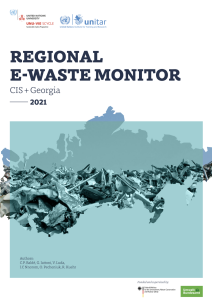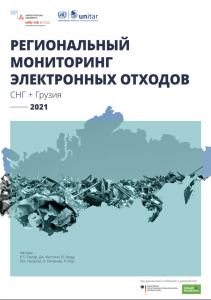
UN Report: E-waste in Eastern Europe / Caucasus / Central Asia Jumps ~50% in a Decade; Just 3.2% Collected, Treated
UN publishes 1st regional e-waste report for Commonwealth of Independent States + Georgia
The regional e-waste total jumped from 1.7 Mt to 2.5 Mt (an average 8.7 kg per citizen), with Russia generating the most e-waste in both absolute and per inhabitant terms.
The findings are published in the first-ever “Regional E-waste Monitor, CIS + Georgia,” produced by the Sustainable Cycles (SCYCLE) Programme, co-hosted by the UN University (UNU) and the UN Institute for Training and Research (UNITAR), in partnership with the UN Environment Programme (UNEP).
According to the study, the region’s e-waste spans a variety of products but three categories dominate: temperature exchange equipment (e.g. heating, air conditioning, and refrigeration units), and large equipment (e.g. washing machines or ovens) and small equipment (e.g. kitchen equipment or vacuum cleaners) account for 77%.
The annual growth rate in the region has slowed in nearly all categories but remains positive. Only screens and monitors, and small IT equipment, show negative growth rates.
“E-waste constitutes one of the fastest growing waste streams in today’s global environment and poses a significant threat to both health and sustainable development,” says Ruediger Kuehr, Director of the Sustainable Cycles Programme (SCYCLE).
“However, few countries collect internationally comparable e-waste statistics, and many countries lack the capacity to collect e-waste data at both the regional and national level. We need this data to track changes over time, establish national and international policies, limit e-waste generation, prevent illegal dumping, and promote recycling.”
"This Regional E-waste Monitor for the CIS + Georgia is the first of its kind, reviewing e-waste statistics, legislation, and management, created with the aim of enhancing understanding and interpretation of the problem and facilitating the environmentally sound management of e-waste.”
“Such a summary allows for international comparisons and contributes to the development of more effective regional e-waste management systems,” he adds.
10 tonnes of gold
Co-author Kees Balde of the United Nations University underlines that managing e-waste could be an economic opportunity in the region by creating enterprises and thus jobs in the recycling sector.
E-waste generated in the CIS + Georgia in 2019 alone contained 10 tonnes of gold, half a tonne of rare earth metals, 1 million tonnes of iron, 85,000 tonnes of copper, 136,000 tonnes of aluminum, and 700 tonnes of cobalt – representing a total value of US $2.6 billion in secondary raw materials.
Meanwhile, hazardous substances in the region’s 2019 e-waste included at least 2.4 tonnes of mercury, 1.1 tonnes of cadmium, 8,100 tonnes of lead, and 4,000 tonnes of brominated flame retardants -- threats to human and environmental health.
“E-waste collection rates need to increase across countries in the region, just as they need to increase elsewhere across the world,” says Dr. Balde. “This improvement can be realised through mandatory handover of e-waste to licenced facilities. Also needed are mandatory reporting obligations for all actors collecting e-waste.”
UBA president Dirk Messner emphasizes that “E-waste is one of the most challenging waste streams all over the world. The amount of electrical and electronic equipment put on the market is rising constantly and thus e-waste does. In Germany we, too, are facing the challenge to boost our collection rates to treat e-waste in the proper way. Policy makers worldwide need a comprehensive analysis of the e-waste situation – both regionally and on a national level. We are happy that through the Advisory Assistance Programme (APP) we have supported this important project. It has been a fruitful exchange and knowledge transfer for both sides.”
Additional findings / News release in full: https://bit.ly/3Hz9FYe
На русском / in Russian: https://bit.ly/3wZStWW
Terry Collins
Terry Collins & Assoc. inc
+1 416-878-8712
email us here
EIN Presswire does not exercise editorial control over third-party content provided, uploaded, published, or distributed by users of EIN Presswire. We are a distributor, not a publisher, of 3rd party content. Such content may contain the views, opinions, statements, offers, and other material of the respective users, suppliers, participants, or authors.




